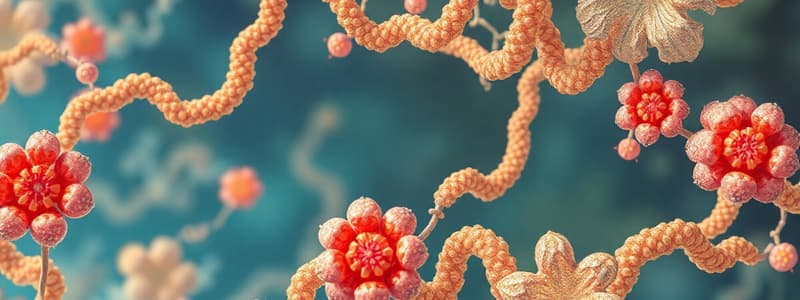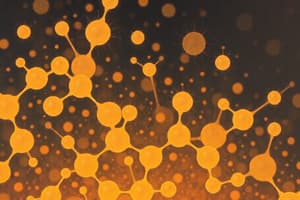Podcast
Questions and Answers
What is the primary function of enzymes in biochemical reactions?
What is the primary function of enzymes in biochemical reactions?
- To catalyze specific reactions by binding with substrates (correct)
- To act as substrates in reactions
- To change the overall energy of the reaction
- To remain unchanged after the reaction
How do buffers contribute to biochemical processes?
How do buffers contribute to biochemical processes?
- By increasing hydrogen ion concentration
- By acting as substrates in enzymatic reactions
- By changing the reaction temperature
- By maintaining a stable pH environment (correct)
Which property of water makes it effective as a solvent for many substances?
Which property of water makes it effective as a solvent for many substances?
- Its ability to form covalent bonds
- Its polarity and hydrogen bonding capability (correct)
- Its high viscosity
- Its low heat capacity
What role do redox reactions play in metabolic processes?
What role do redox reactions play in metabolic processes?
What is the main energy currency of the cell?
What is the main energy currency of the cell?
What is the primary function of proteins in living organisms?
What is the primary function of proteins in living organisms?
Which biomolecule is primarily responsible for energy storage in plants?
Which biomolecule is primarily responsible for energy storage in plants?
What is the structure that DNA is composed of?
What is the structure that DNA is composed of?
What key process occurs during catabolism?
What key process occurs during catabolism?
Which statement about enzymes is correct?
Which statement about enzymes is correct?
What type of biomolecule is primarily involved in the structure of cell membranes?
What type of biomolecule is primarily involved in the structure of cell membranes?
Which metabolic pathway is associated with the breakdown of glucose in the presence of oxygen?
Which metabolic pathway is associated with the breakdown of glucose in the presence of oxygen?
What category of biomolecules includes fats and steroids?
What category of biomolecules includes fats and steroids?
Flashcards
Biochemistry
Biochemistry
The study of chemical processes in living organisms, including biomolecules.
Proteins
Proteins
Complex biomolecules made of amino acids, performing many functions like enzymes and transport.
Protein Structure
Protein Structure
The arrangement of amino acids determines protein's 3D shape and function.
Carbohydrates
Carbohydrates
Signup and view all the flashcards
Lipids
Lipids
Signup and view all the flashcards
Nucleic Acids
Nucleic Acids
Signup and view all the flashcards
Metabolism
Metabolism
Signup and view all the flashcards
Catabolism
Catabolism
Signup and view all the flashcards
Anabolism
Anabolism
Signup and view all the flashcards
Enzymes
Enzymes
Signup and view all the flashcards
Cellular Respiration
Cellular Respiration
Signup and view all the flashcards
Enzyme Specificity
Enzyme Specificity
Signup and view all the flashcards
Enzyme Active Site
Enzyme Active Site
Signup and view all the flashcards
pH
pH
Signup and view all the flashcards
Optimal pH Range
Optimal pH Range
Signup and view all the flashcards
Buffer
Buffer
Signup and view all the flashcards
Water as Solvent
Water as Solvent
Signup and view all the flashcards
Water's Properties
Water's Properties
Signup and view all the flashcards
Thermodynamics in Biochem
Thermodynamics in Biochem
Signup and view all the flashcards
Free Energy
Free Energy
Signup and view all the flashcards
Redox Reactions
Redox Reactions
Signup and view all the flashcards
Cellular Respiration
Cellular Respiration
Signup and view all the flashcards
Co-enzymes
Co-enzymes
Signup and view all the flashcards
Bioenergetics
Bioenergetics
Signup and view all the flashcards
ATP
ATP
Signup and view all the flashcards
Study Notes
Introduction to Biochemistry
- Biochemistry is the study of chemical processes within and relating to living organisms.
- It encompasses the structure, function, and interaction of biomolecules like proteins, carbohydrates, lipids, and nucleic acids.
- It overlaps significantly with other disciplines such as molecular biology, genetics, and physiology.
- Understanding biochemistry is crucial for comprehending life processes and developing treatments for diseases.
Biomolecules: Structure and Function
- Proteins: Complex polymers of amino acids.
- Perform a vast array of functions, including catalysis (enzymes), transport, signaling, and structural support.
- Their structure is crucial to their function. The primary structure (amino acid sequence) dictates the secondary (e.g., alpha-helices, beta-sheets), tertiary (overall 3D shape), and quaternary (multiple polypeptide chains interacting) structures.
- Protein folding determines its activity.
- Carbohydrates: Include monosaccharides, disaccharides, and polysaccharides.
- Serve as a primary energy source and structural components (e.g., cellulose).
- Bonds between monosaccharides form disaccharides and polysaccharides such as starch and glycogen, which are important for energy storage.
- Lipids: Diverse group of hydrophobic molecules.
- Include fats, phospholipids, and steroids.
- Important for energy storage, membrane structure, hormone production, and insulation.
- Phospholipids are crucial components of cell membranes.
- Nucleic Acids: DNA and RNA.
- Carry genetic information.
- DNA (deoxyribonucleic acid) stores the genetic code, and RNA (ribonucleic acid) plays crucial roles in protein synthesis, gene regulation and other cellular processes.
- Their structure involves nucleotides, which are linked to form polynucleotide chains.
Metabolism
- Metabolism encompasses all chemical reactions in a cell.
- Catabolism: Breakdown of complex molecules to release energy.
- Key pathways include glycolysis, the Krebs cycle, and oxidative phosphorylation.
- Anabolism: Synthesis of complex molecules from simpler ones, utilizing energy.
- Examples include protein synthesis, glycogen synthesis, and lipid synthesis.
- Cellular Respiration: Metabolic process that releases energy from glucose in the presence of oxygen.
Enzymes
- Enzymes are biological catalysts that speed up the rate of chemical reactions.
- They act by lowering the activation energy.
- Enzymes are highly specific, typically catalyzing only one type of reaction.
- Their active sites bind with substrates and catalyze reactions.
pH and Buffers
- pH is a measure of hydrogen ion concentration.
- Enzymes and other biomolecules function optimally within a narrow pH range.
- Buffers help maintain a stable pH by resisting changes in hydrogen ion concentration.
- Understanding and controlling pH is critical to most biochemical processes.
Water
- Water is the universal solvent of life.
- Its unique properties (polarity, hydrogen bonding) enable it to dissolve many substances.
- Water's high heat capacity and heat of vaporization are crucial for thermoregulation in living organisms.
Thermodynamics
- Biochemical reactions follow the laws of thermodynamics.
- Understanding free energy changes and equilibrium constants is crucial in predicting the spontaneity and feasibility of biochemical reactions.
Redox Reactions
- Redox reactions involve the transfer of electrons.
- Crucial in metabolic processes such as cellular respiration.
- Co-enzymes frequently participate in electron transfer, including NAD+ and FAD.
Introduction to Bioenergetics
- Study of energy flow within living things.
- Energy is stored and released in chemical bonds of biomolecules.
- Understand the energy currency of the cell, ATP (adenosine triphosphate).
Studying That Suits You
Use AI to generate personalized quizzes and flashcards to suit your learning preferences.




